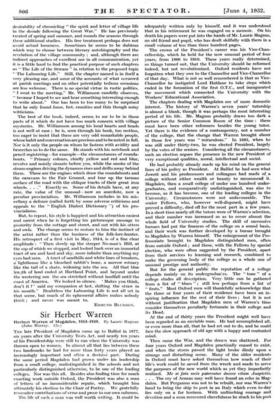New Country Conversations
The Labouring Life. By Henry Williamson. (Cape. 7s. od.) Pmurnes the country is not so obvious an inspiration now for the writing kind as it was when J. W. Waiter sat at Tarring, accumulating that hearty book The Seaboard and the Down, or when Richard Jefferies wandered Round About a Great Estate, or even when we all fell in for the safety, honour and welfare of our village ; but the enthusiasm and the success of such writers as Mr, H. J. Massinghani, Mr. Adrian Bell, and the author of The Labouring Life prove that there Is still a rural world worth finding in life or in literature. The cry of " archaism," " pastoral," " sentiment," may be raised when such authors appear, but they need not fear it ; the country Is not altogether urbanized yet, some know how to fork hay and others how to bottom a chair, there are plenty of bluebells and there arc kingfishers, and downs without shed or shack,
In his new book Mr. Williamson presents with a free hand sketches, descriptive or narrative, of " one village and its neighbourhood," having in mind besides entertainment the desirability of chronicling " the spirit and letter of village life in the decade following the Great War." He has previously treated of spring and summer, and rounds the seasons through these additional studies. His free treatment perhaps does not avoid actual looseness. Sometimes he seems to be dubious which way to choose between literary autobiography and the revelation of the village community ; and, although there are indirect approaches of excellent use in all communication, yet it is a little hard to find the practical purpose of such chapters as " The Life of the Stream " in relation to the proposed topic `' The Labouring Life." Still, the chapter named is in itself a very pleasing one, and some of the accounts of what occurred at parish meetings and on other potentially tedious occasions are less welcome. There is no special virtue in rustic politics.
I went to the meeting," Mr. Williamson candidly observes, because I hoped to see and hear something interesting enough to write about." One has been to too many to be surprised that he only found fume, fret, enmities and thin though noisy witticisms.
The best of the book, indeed, seems to me to be in those parts of it which do not have too much concern with village mysteries. Mr. Williamson among his local hearts and heads is not well at ease ; he is, seen through his book, too restless, too eager to insist that these are very odd remarkable people, whose habit and conversation are precious and to be noted in full. Nor is it only the people on whom he fastens with avidity and beseeches us to do the same. He stands with his notebook and pencil registering—for example—the circumstances of rounda- bouts. " Primary colours, chiefly yellow and red and blue, revolve and noisily sinuate before you, while the smoke of the steam-engines driving the dynamos rises and drifts away behind them. These are the engines which draw the roundabouts and the caravans to the Fair Ground, and tear up the tarmac surface of the road with the oblique tracks of their great iron wheels. . . ." Exactly so. Some of his details have, at any rate, the value of the unusual—now an anecdote, now a peculiar provincialism. Mr. Williamson includes in his mis- cellany a defence (called forth by some adverse criticisms and appeals to the English Dialect Dictionary ") of his pro- vincialisms.
But, to repeat, his style is happiest and his attraction easiest and surest when he is forgetting his picturesque message to posterity from the cottage and street, and out with his otters and owls. The change seems to restore to him the instinct of the artist rather than the business of the folk-lore-hunter. His retrospect of a first visit in May, 1914, is of a fine clear amplitude : " Then slowly up the steeper No-man's Hill, at the cop of which we stopped, and looked back over an immortal tract of sea and land and sky, more infinite than anything my eyes had seen. A tract of sandhills and white lines of breakers, a lighthouse like a bleached rabbit's bone, a narrow estuary like the tail of a skate, widening into the sea. All that blue len;th of land ended at Hartland Point, and beyond under the westering sun the sea stretched without landfall until the coast of America. We looked in silence. ' Makes you think, don't it ? ' said my companion at last, shifting the straw in his mouth." Doubtless the Labouring Life is not all set in that scene, but much of its ephemeral affairs makes nobody think ; and never was meant to.
EDMUND BLUNDEN.





































 Previous page
Previous page